Field Judging Elk - 2
Another anatomical measurement that can be used when determining point length is the distance from the top of the back to the bottom of belly. That measurement is generally about 26-28 inches depending on the maturity of the bull. When a bull is broadside, you can compare his fourth point to that measurement. If the point is six inches shorter, then the bull probably has a 20-inch fourth point. Once you estimate the length of the fourth points, move to the fifths and compare them with the fourths to determine their length.
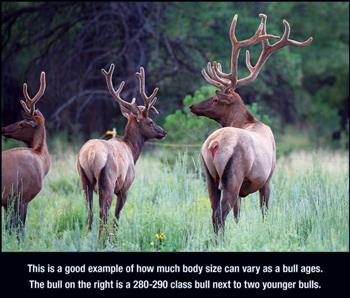
Main Beam - Next, I estimate the length of the main beam by using an important anatomical measurement. When a bull has his head down feeding, I determine whether the main beam is higher or lower than the hump on his back above his shoulder. The distance from that hump down his front leg to his hoof is generally 52-56 inches, depending on the maturity of the bull. If the tip of the main beam comes to the top of the hump then the beam is probably around 50 inches. If it is shorter or longer than the hump on the back, I add or subtract inches accordingly.
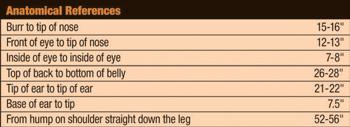
Mass - Determining the four mass measurements per side is usually difficult, so I use a little rule of thumb. If the rack doesn't look heavy and has a thin appearance, I attribute 27 inches of mass per side or 54 inches total. If a bull looks really heavy and solid, then I estimate about 30 inches of mass per side. Trying to determine mass is very hard and requires scoring quite a few racks, but if you use those numbers, you will often be close.
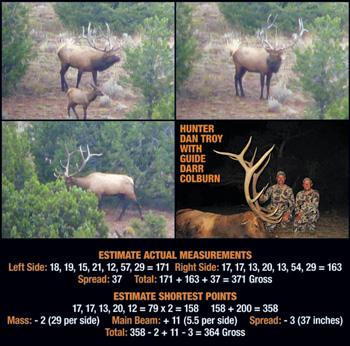
Inside Spread - The last measurement to estimate is inside spread, which is the widest point from the inside of one beam to the inside of the other. I often use two anatomical measurements: 1) the distance from ear tip to ear tip (21-22 inches); and 2) the actual ear length itself (7.5 inches). The only way to really estimate the inside spread of a bull elk is for him to face you. When he's facing you, look at the width of his ears. If you can add one ear length to each side, that should put you at a 37-inch inside spread (22 + 7.5 + 7.5 = 37). If you can add an ear and a half to each side, then the inside spread measures approximately 45 inches. Keep in mind that very few bulls are wider than 45 inches inside.
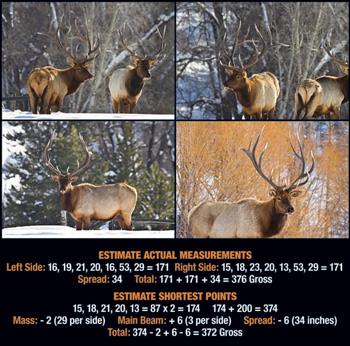
There is quite a bit of "air judging" that gets done while estimating measurements, but if you use anatomical references, you can often get pretty close to the real measurement. Just to be sure, I cross-referenced anatomical measurements with Clay Goldman of Mogollon Taxidermy. You may want to do this with a taxidermist in your area.
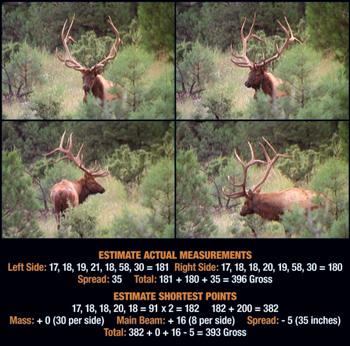

Main Beam - Next, I estimate the length of the main beam by using an important anatomical measurement. When a bull has his head down feeding, I determine whether the main beam is higher or lower than the hump on his back above his shoulder. The distance from that hump down his front leg to his hoof is generally 52-56 inches, depending on the maturity of the bull. If the tip of the main beam comes to the top of the hump then the beam is probably around 50 inches. If it is shorter or longer than the hump on the back, I add or subtract inches accordingly.

Mass - Determining the four mass measurements per side is usually difficult, so I use a little rule of thumb. If the rack doesn't look heavy and has a thin appearance, I attribute 27 inches of mass per side or 54 inches total. If a bull looks really heavy and solid, then I estimate about 30 inches of mass per side. Trying to determine mass is very hard and requires scoring quite a few racks, but if you use those numbers, you will often be close.

Inside Spread - The last measurement to estimate is inside spread, which is the widest point from the inside of one beam to the inside of the other. I often use two anatomical measurements: 1) the distance from ear tip to ear tip (21-22 inches); and 2) the actual ear length itself (7.5 inches). The only way to really estimate the inside spread of a bull elk is for him to face you. When he's facing you, look at the width of his ears. If you can add one ear length to each side, that should put you at a 37-inch inside spread (22 + 7.5 + 7.5 = 37). If you can add an ear and a half to each side, then the inside spread measures approximately 45 inches. Keep in mind that very few bulls are wider than 45 inches inside.

There is quite a bit of "air judging" that gets done while estimating measurements, but if you use anatomical references, you can often get pretty close to the real measurement. Just to be sure, I cross-referenced anatomical measurements with Clay Goldman of Mogollon Taxidermy. You may want to do this with a taxidermist in your area.

